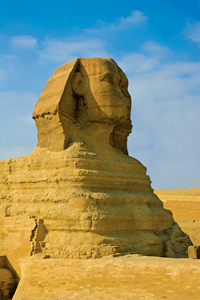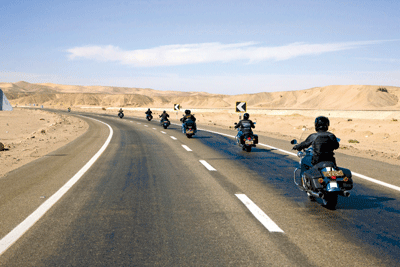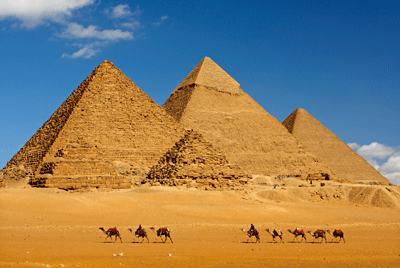Seth, the ancient Egyptian god of chaos, would be in his element. On the backstreets of Hurghada, the traffic has ground to a halt amid a cacophony of cranky car horns, overloaded and lopsided donkey carts and reluctant camels. This morning, which is perhaps a first for the city’s overburdened and cracked roads, there has been no accident, malfunctioning traffic signal or overturned orange cart spread across the highway like spilt marmalade. All eyes are on a dusty car lot at the road’s edge, where Sharif Bergami is tuning, fine tuning, and refuelling an array of the world’s most wanted Harley Davidson motorbikes.
 “We’ll be the kings of the road today,” Bergami purrs from underneath his chrome aviator sunglasses and black and white skullcap. “Everyone in the city will hear us when these machines rev up.”
“We’ll be the kings of the road today,” Bergami purrs from underneath his chrome aviator sunglasses and black and white skullcap. “Everyone in the city will hear us when these machines rev up.”
Like Tutankhamen, Amenhotep and Rameses, a Harley Davidson is a legend in its own right among petrol-heads, and they are proving to be irresistible to the star-struck Egyptians. Wiping down the front fenders, Bergami’s eyes glint in the relentless sun – which could either be a sign of madness or muscle – and he begins to kick-start the engines with the force of a sexually deprived bull. “Lock and load people,” he bellows, “lock and load!” On the desert highways of Egypt today, the only thing louder than a buzzing Harley Davidson is an angry Egyptian.
Ever since the Early Dynastic period began with the unification of Egypt around 3,000 BC, the Egyptians have been masters of transportation. Obelisks could be quarried hundreds of miles from their final resting place and temples were crowned in Nubian sandstone hued from once-mystical sites like Gebel El-Silsila near Kom Ombo. The red granite burial chamber of the Great Pyramid of Giza, towering over the built-up suburbs of Cairo, was even quarried from Aswan and transported some 900km north along the banks of the Nile. The sands of Rameses IV’s cracked hourglass may have run achingly low since then, but times don’t change that much – the Egyptians are still masters of the long-distance road trip.
For the next three days, I will be part of an overland motorbike tour that will stretch from Hurghada’s sapphire-blue coast, through the rugged spine of the interior’s ruby Red Sea Mountains, past the palm fronds and emerald waterways of the serpentine Nile to Luxor, the beating heart of the country’s tourist industry. Created for both Indiana Jones wannabes and Mad Max stunt riders, the trip promises to be a perfect synergy of discovery and adventure, dare devilry and axel grease.
As I position myself astride a cherry red bike, I look to the Red Sea Mountains in the west with anticipation. This is a serious piece of machinery that I have between my legs: the Softail Heritage Classic weighs 350kg and has a 1,584cc air-cooled V-twin 19-litre engine; whatever that means. Despite the lack of reliable stabilisers, however, I’m happy enough with the “Born to be Mild” tag and I know I am in safe hands.

A member of the Cairo Harley Davidson Owners Group, Bergami is a self-confessed motorbike addict and highly competent tour leader for our cross-country ride. Kitted out in fingerless leather gloves and a tassel waistcoat complete with authoritative Sheriff badge, he is one part army squadron leader to two parts wise cracking Mel Brooks comic. “Time to go ladies and gentlemen,” he barks, bending his handlebars towards him as though they were sun-ripened bananas. “Let’s show this town what these bikes can do.”
Moments later, our engines are kick-started and my eyes are suddenly blinded with desert dust. Like proverbial bats out of hell, our tyres attack the road in front of us and the backs of my eyes begin to burn and streak with black and orange; the colours of lost Tutankhamen treasures and Harley Davidson saddlebags. It’s time to create a mythology all of my own.
Weaving in and out of the highway traffic like a swarm of synchronic honeybees, our group of 10 bikes leaves the waving and whooping crowds of Hurghada behind for the Egypt I have only ever read about in storybooks. I find myself captivated by rock arches, archaic canyons and every shade of red and tangerine in the Arabic dictionary. There are scarlet sandstones, aged burgundy rock-faces, russet-red dunes and ashen cherry trees, all languishing beneath the 40-degree crimson sky. “It’s not the quality of the roads that brings travellers to Egypt but the history, nature and the wide open space,” howls Bergami as he draws up next to me, a wind-defying cigarette nonchalantly taped to his lower lip. “You can smell it in the air.” His bike belches out smoke and he disappears over the horizon in front of me with the group at his heels. We must be doing 140km/h.
Several adrenaline-fuelled hours later, and as the shadows begin to stretch, we eye our destination. Sitting amid the yellow desert, against a backdrop of cultivated green fields and the ochre Libyan Chain Mountains, Luxor grows to life on the road ahead. Entering the city limits, and with dirt streaks on our faces greased like pharaoh war paint, we arrive in time to witness the city’s daily pre-dinner ballet.
Bouncing on the candescent river Nile next to us, I see waving Nubian fishermen row to shore on their skeletal boats, dragging nets full of Nile fishes and, perhaps, the odd confused and off-course crocodile. Further from shore, the white sails from the traditional Egyptian sailing boats, the felucca, pirouette on the Nile, and in the distance, the temples of Luxor catch a breath as worn out tourist groups head for the exit gates.
Once one of the world’s great cities, Luxor remains a captivating modern city, with its five-star Hilton and Sheraton hotels, fast-paced banks and even faster-talking tourist touts. But it is ancient Thebes, capital of the Egyptian empire for almost a thousand years, which has brought us across the Red Sea Mountains to the doors of its famed temples and tombs. It is in front of Karnak Temple’s mythological gates – during the complex’s nightly Sound and Light show – that I begin to truly immerse myself in the golden age of the ancient Egyptians.
 Adorned with a wealth of decorative and architectural detail, the entrance to Karnak is spearheaded by an avenue of miniature sphinxes, which bow down in subservience to Amun, the king of Egyptian Gods. Walking through Karnak Temple’s hypostyle hall of 134 columns – the largest in the world – and around the Sacred Lake, it is easy to understand why the stars are radiating above; they are the eyes of the true kings blinking their approval at Luxor’s splendour. Homer, author of The Iliad and The Odyssey rather than The Simpson’s yellow-skinned philosopher, described “the hundred-gated Thebes,” where, “only the grains of sand of the desert surpassed the quantity of riches enclosed within”. Tonight, with the tourist cameras flashing like paparazzi, it is clear that Thebes is very much still a priceless commodity.
Adorned with a wealth of decorative and architectural detail, the entrance to Karnak is spearheaded by an avenue of miniature sphinxes, which bow down in subservience to Amun, the king of Egyptian Gods. Walking through Karnak Temple’s hypostyle hall of 134 columns – the largest in the world – and around the Sacred Lake, it is easy to understand why the stars are radiating above; they are the eyes of the true kings blinking their approval at Luxor’s splendour. Homer, author of The Iliad and The Odyssey rather than The Simpson’s yellow-skinned philosopher, described “the hundred-gated Thebes,” where, “only the grains of sand of the desert surpassed the quantity of riches enclosed within”. Tonight, with the tourist cameras flashing like paparazzi, it is clear that Thebes is very much still a priceless commodity.
Twelve hours, a hot shower, a cold beer and a 20-minute bike ride later, I come face to face with the famed Colossi of Memnon. The 20m high Colossi are all that remain of the burial temple of Amenhotep III but still – centuries later – sit as the patient gatekeepers to the Valley of the Kings and its tombs of despair and antiquity. They are like faceless lapdogs, panting in the heat, begging with visitors for attention.
Back on our bikes, and cruising past the tour buses and touts in a zigzag valkyrie-formation, the eternal Valley of the Kings – the necropolis of the Egyptian sovereigns from the 18th to the 20th Dynasty – rises like a vision to meet us. Overweight package tourists balance precariously on top of parched donkeys, and I too can feel the thirst building up in my throat – but only from the adrenaline.
Looking on at more than 3,500 years of history compacted into a single valley, it is easy to marvel at Egypt’s past majesty. An extraordinary 62 tombs are scattered like secret caves and passages underneath the bronze sands, worn out sandals and sweaty feet. Though the valley is the final resting place of King Tutankhamen – whose iconic gold and blue funerary mask is the highlight of any trip to Cairo’s Museum of Egyptian Antiquities – it is also home to some of Ramses II’s estimated 52 sons, Tuthmosis, Amenhotep and other mummified Hammer horror popcorn legends.
The first tomb along the approach to the centre of the valley contains the sarcophagus of Rameses IV, sovereign of the 20th dynasty and son of Rameses III. “It is the largest in the entire valley,” says our tour guide Ahmed, who smiles as though he has snorted too much sugar. “Please remember – don’t touch anything. The murals have been preserved here for thousands of years and we only want to leave footprints”. Bergami gives me a wink: in our case, its thick rubber tyre tracks.
Armed with a torch, an adventurer’s fedora (okay, it’s a box motorbike helmet) and a bullwhip (the best I can do is to dust off my rapier wit), we clamber into the depths of the tomb, shielded from the heat by a blanket of dry air and centuries old dust. Though there aren’t any trapdoors, it is easy to imagine oneself as a Tomb Raider – or in this case as a Tomb Rider. Before me, on the lid of one sarcophagus is a relief of Rameses IV between the goddesses Isis and Nephthys. I see ancient murals and hieroglyphics and find myself being transported back to the 1930s and on the hunt for the Lost Ark.
As I later learn from Ahmed, Seti I’s tomb, which was discovered in 1817, lies further up the serpentine valley and – with its extensive relief work and paintings – is thought to be the finest tomb yet discovered in Egypt.
Clambering back into the daylight, I prepare myself for the final leg of our cross-country journey back to the Red Sea coast. As we remount, the clouds gather above and I imagine them as the shadows of Horus, the god of the sky, and a Harley Davidson trademark American eagle. Once more, it’s time to burn rubber and I have a crescent moon shaped smile on my face that would make even King Tut jealous. I’m sure the dust will be stuck between my teeth for weeks.
FAST FACTS
GETTING THERE: Egyptair (www.egyptair.com) operates a 10-hour flight four times weekly from Kuala Lumpur to Cairo. Its codeshare flight from Singapore, operated by Singapore Airlines (www.singaporeair.com), flies four times weekly to Cairo.
ACCOMMODATION: The perfect place to dust off the dirt and the centuries-old cobwebs from your tomb-raiding adventure, the Sheraton Luxor Resort (www.sheratonluxor.com) offers the largest panoramic view of the Nile River in the city. With ample parking – especially for a convoy of classic Harley Davidsons should they roll into town unexpectedly – and the Sukkareya bar, which distracts many a weary traveller, the Sheraton is the connoisseur’s choice when on the hunt for the ancient treasures of Luxor. Of course, it is the classic riverside view that keeps this five-star hotel perpetually busy – is there really any better place in the city for a soothing sundowner? – and its trilogy of alfresco Mediterranean-Italian-Arabic dining venues is as nouvelle cuisine as the Nile valley gets. Lavishness that not even Cleopatra – or an Elizabeth Taylor decked out in far too much mascara – could dream up.
TRANSPORT: For Harley Davidson enquiries, contact Indji Ghattas, Cairo’s dealer principal at http://harley-davidsonegypt.com








